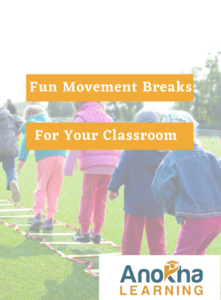
Why use movement breaks in the classroom?
Have you ever sat on a hard chair during a staff training and found it hard to sit still? Feigning interest, stifling a yawn and trying to sneak a peek at your watch to see if it’s nearly break time? If so, you will understand how your pupils might be feeling after a particularly taxing lesson!
Movement breaks can work well in the classroom by:
- Helping children to release physical, mental and emotional tension
- Supporting children with additional needs who may find it difficult to sustain focus for prolonged periods, for example children with diagnoses such as ADHD, anxiety and dyspraxia
- Signalling a transition
- Creating a sense of fun and belonging
- Dissipating conflict (e.g. after the yard)
- Revitalising the class when they hit the afternoon slump
- Encouraging children to become more appreciative of their bodies.
- Raising awareness of the link between healthy habits such as sleep, nutrition, exercise and a healthy mind and body
Movement breaks can be fast or slow depending on the needs of the children. For example, mindful movement can help children to connect to their senses and help them to tune into their bodies and their surroundings. Slow, deliberate movement can be soothing.
With a jam-packed curriculum it can feel like there isn’t enough time to incorporate movement breaks into your practice. Hopefully the benefits listed above will help to persuade you it’s well worth carving out this time.
Fun movement break ideas
In this section, we’ll roundup some of the most popular ideas shared by course tutors and participants so that you can give them a go. These activities are tried and tested so have a read as you might find one to add to your bag of tricks! We’re including a range of calming and more energetic activities for you to choose from to best meet the needs of the children in your care.
Tip: Try incorporating a few mindful breathing exercises before you start to help everyone to relax and unwind.
- Try out the Run around Ireland Challenge. Get out of the classroom and run, jog or walk. Then add up the number of kilometres and track them on a chart. Our friend Niamh at Irish Primary teacher documented her experience the with the Run around Ireland Challenge in a blog post. She also gives some lovely tips for weaving Geography and Maths into the challenge.
- Experiment with online resources such as GoNoodle, Cosmic Kids Yoga and Just Dance to find an age-appropriate movement break that engages your class.
- Have a Walking Debate. Simply put, this is where children express their views by moving around the room to indicate their stance on a given issue. This could be challenging to implement in the current climate, but it's a lovely one to file away for future use.
- If you sometimes get stuck for ideas it can be useful to have a bank of activities to hand. These printable cards feature a wide variety of movement breaks. Many of the suggested exercises can be done on the spot and none of them require any additional equipment, so they are easy to implement.
More resources for you to explore
These resources come highly recommended by other practitioners:
Free resources
- The Daily Mile as recommended by our course author Dr. David Coleman.
- Get Ireland Active resource from the HSE. This guide is jam-packed with movement break ideas and teaching points around safety before you begin. It also gives ideas for classroom management and the suggested age range each activity is suitable for. This resource would be fantastic to dip into on rainy days when the children may be feeling antsy.
- Read this post for some three-minute movement break activity ideas.
Paid resources
- Recommended read: “Sensory Circuits: A Sensory Motor Skills Programme for Children“ by Jane Horwood
- Mindfulness Matters CDs and resources
Tip: Try adding a bit of drama to the process by using the wheel of names random generator to choose a movement break activity. (Enter the names of the various activities on the wheel of names random generator and select one at random!).
We hope this post is helpful. Share these tips with a colleague or print them out so that you have them to hand next time you’re stuck for an idea! If you are teaching at the infant end of the school, make sure to read our blog post "how to use movement breaks in the infant classroom".
How have you used movement breaks in your classroom? Drop us a line, we’d love to know!
